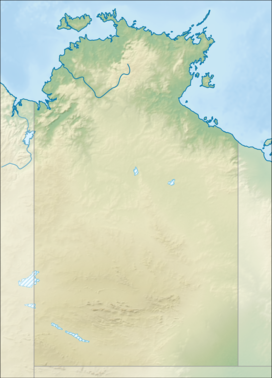Mount Conner
| Mount Conner | |
|---|---|
 Mount Conner seen from the road to Uluru / Ayers Rock | |
| Highest point | |
| Elevation | 859 m (2,818 ft)AHD |
| Coordinates | 25°29′34″S 131°53′52″E / 25.492807°S 131.897828°E[1] |
| Naming | |
| Etymology | M. L. Conner |
| Geography | |
| Location | Petermann, Northern Territory,[1] Australia |

Mount Conner, also known as Artilla or Atila, or tongue-in-cheek as Fooluru, is a mountain located in the southwest corner of the Northern Territory of Australia.
Location and description
[edit]Mount Conner is located 75 kilometres (47 mi) southeast of Lake Amadeus, in the locality of Petermann.[1] It lies within the Curtin Springs cattle station in Pitjantjatjara country,[2] close to the site of the Kungkarangkalpa (Seven Sisters) Dreaming.[3]
Its height reaches 859 metres (2,818 ft) above sea level and 300 metres (984 ft) above ground level.[4]
Names
[edit]Mount Conner was named after M. L. Conner by explorer William Gosse in 1873. Its Aboriginal name is "Artilla" or "Attila", believed to be associated with the "terrible ice-man" story.[1]
It is also known by locals as "Fool-uru" or "Fuluru", owing to tourists sometimes confusing it with Uluru.[5][6]
Geology
[edit]The sides of Mount Conner are blanketed by scree (talus) and its top is blanketed by colluvium. The base of Mount Conner is surrounded by alluvium.[7][8][9]
The summit of Mount Conner, along with the summits of low domes in the Kata Tjuta complex and summit levels of Uluru, is an erosional remnant of a Cretaceous geomorphic surface. It is considered to be a classic example of an inselberg created by erosion of surrounding strata.[10]
See also
[edit]References
[edit]- ^ a b c d "Place Names Register Extract for "Mount Conner"". NT Place Names Register. Northern Territory Government. Retrieved 14 June 2019.
- ^ "Central Australia, 1940". SA Memory. State Library of South Australia. 29 October 2009. Retrieved 19 September 2015.
- ^ "Seven Sisters Dreaming". 24 March 2014. Retrieved 19 September 2015.
- ^ "Mount Conner". Encyclopædia Britannica Online. Encyclopædia Britannica. 2011.
- ^ Patowary, Kaushik (13 June 2016). "Mount Conner: The Rock That Fools You". Amusing Planet. Retrieved 9 April 2023.
- ^ Junker, Ute (4 March 2015). "'Fool-uru': The rock tourists think is Uluru". Stuff. Retrieved 14 April 2022.
- ^ Young, DN, N Duncan, A Camacho, PA Ferenczi, and TLA Madigan (2002a) Ayers Rock, SG 52-8 map, 1:250 000 Geological Series (Second Edition), Northern Territory Geological Survey. scale 1:250 000, Darwin, Northern Territory Geological Survey, Australia.
- ^ Young, DN, N Duncan, A Camacho, PA Ferenczi, and TLA Madigan (2002b) Ayers Rock, SG 52-8 Explanatory Text, 1:250 000 Geological Series (Second Edition). scale 1:250 000, Darwin, Northern Territory Geological Survey, Australia.
- ^ Edgoose, CJ (2012) The Amadeus Basin, central Australia. Episodes. 35(1):257-263.
- ^ Twidale, C.R. (2007) Ancient Australian Landscapes. Rosenberg Publishing, Kenthurst, New South Wales. 144 pp.
Additional sources
[edit]- Ayers Rock Geology Map (Map) (1st ed.). 1:250,000. Sheet SG52-8. Northern Territory Geological Survey. 1967.
- Ayers Rock Geology Map (Map) (2nd ed.). 1:250,000. Sheet SG52-8. Northern Territory Geological Survey. 2002.
- Johnson, David (2004). The Geology of Australia. Cambridge University Press. ISBN 0-521-84121-6.
Further reading
[edit]- Thompson, R B (1995). A Guide to the Geology and Landforms of Central Australia. Alice Springs: Northern Territory Geological Survey. ISBN 0-7245-2527-0.

